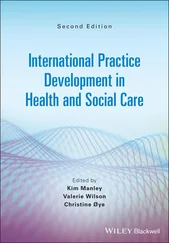Preparing for Professional Practice in Health and Social Care
Здесь есть возможность читать онлайн «Preparing for Professional Practice in Health and Social Care» — ознакомительный отрывок электронной книги совершенно бесплатно, а после прочтения отрывка купить полную версию. В некоторых случаях можно слушать аудио, скачать через торрент в формате fb2 и присутствует краткое содержание. Жанр: unrecognised, на английском языке. Описание произведения, (предисловие) а так же отзывы посетителей доступны на портале библиотеки ЛибКат.
- Название:Preparing for Professional Practice in Health and Social Care
- Автор:
- Жанр:
- Год:неизвестен
- ISBN:нет данных
- Рейтинг книги:3 / 5. Голосов: 1
-
Избранное:Добавить в избранное
- Отзывы:
-
Ваша оценка:
- 60
- 1
- 2
- 3
- 4
- 5
Preparing for Professional Practice in Health and Social Care: краткое содержание, описание и аннотация
Предлагаем к чтению аннотацию, описание, краткое содержание или предисловие (зависит от того, что написал сам автор книги «Preparing for Professional Practice in Health and Social Care»). Если вы не нашли необходимую информацию о книге — напишите в комментариях, мы постараемся отыскать её.
Preparing for Professional Practice in Health and Social Care
Preparing for Professional Practice in Health and Social Care
Preparing for Professional Practice in Health and Social Care — читать онлайн ознакомительный отрывок
Ниже представлен текст книги, разбитый по страницам. Система сохранения места последней прочитанной страницы, позволяет с удобством читать онлайн бесплатно книгу «Preparing for Professional Practice in Health and Social Care», без необходимости каждый раз заново искать на чём Вы остановились. Поставьте закладку, и сможете в любой момент перейти на страницу, на которой закончили чтение.
Интервал:
Закладка:
The HCPC, which is the professional regulator in the United Kingdom, give clear expectations of threshold standards regarding reflection that are in place to protect the public. All health and social care professionals are expected to reflect on and review their practice, although there are subtle differences between professions in terms of how this is expected to occur. This brings us on to valuing a range of approaches to reflection, whether this is an individual act or something undertaken with others. Core to each of the HCPC professional standards for proficiency is the need to ‘record the outcome of such reflection’ as outlined in Standard 11.1 for occupational therapists (HCPC 2018) highlighting that reflection, and documenting it, is essential to maintain professional registration within the United Kingdom.
There are a multitude of methods and settings where reflection can occur and these are outlined below.
Case conferences –although there is a need to shift from viewing these as meeting to only discuss a client, to actively considering how things can be delivered differently through interprofessional collaboration, debriefing, and simulation. This is supported by the HCPC through valuing multidisciplinary team reviews in standards of proficiency for example with dieticians (HCPC 2013a), paramedics (HCPC 2014), and chiropodists/podiatrists (HCPC 2013b).
Supervision –1:1, with a peer, and within and across professions.
Debriefing –there are a range of techniques used as a means of facilitated, guided reflection as part of a debrief process. This can involve formal, structured techniques or more ad-hoc debriefing with peers, or facilitators, in pairs or groups.
Stakeholder meetings –these meetings are often strategic events to bring people together to discuss and commit to particular projects or developments (as in case study 1). This can be a great opportunity for reflection from multiple perspectives and may take a problem solving or appreciative inquiry (exploring strengths) focus.
Individual methods –reflective questions, diaries, reflective models (see case study 2), engaging in post-graduate study (case study 3), and as technology evolves, using mobile apps.
Schwartz rounds –The principles of Schwartz rounds are discussed in Chapter 2(Care and Self-Care).
Models of Reflection
To deepen the engagement in a reflective cycle and become more reflexive, models can assist through providing a structure and prompts. The preference for a particular model of reflection is often based on previous experience, exposure to a particular model, personal preference, learning style, professional bias, or the time prioritised to engage with reflection. Reflective models stem from the work of Kolb in the 1980s on the experiential learning cycle with four stages of reflection crucial for learning to occur (Kolb 1984). Models of reflection have evolved to some degree over time and they differ in complexity. The models by Gibbs (1988) and Johns (1995) are popular within the health and social care professions as they involve responding to key questions within a linear or cyclical method. Some practitioners prefer the models by Boud and Walker (1990) as they have more stages or strands to revisit and potentially promote a more reflexive approach. More recently, Jasper (2013) developed a framework, ERA (Experience, Reflection, Action) which encourages building understanding from experience through reflection to move forward into action. When reviewing methods to promote reflection it is important to trial and critique a variety of techniques individually and with others to maximise your potential to be a reflective practitioner.
Case Study 2 – Individual Reflection (Model of Reflection): Realisation that Not as Evidence Based in Practice as First Thought
Working as an Allied Healthcare Professional in a community rehabilitation team, Nick identified that there were some inconsistencies in how complexity of healthcare needs was being defined when prioritising referrals. On reflection, Nick considered that this might be due to different professional viewpoints on how complexity of need is assessed and a range of practice experience across team members. Reviewing evidence was used as a way to improve the triage process to ensure that clients received the appropriate care and access to services. The process involved defining what complexity was in relation to context, reviewing government policy/guidance, and identifying triage tools to implement in practice. To facilitate this process Nick utilised a change management tool and also used a model of reflection, both were valuable in keeping this project on track and adding depth to learning from the process. Nick felt that sometimes undertaking a specific project, while providing useful outcomes for practice, can also highlight that as practitioners we are not as evidence-based as first thought.
Case Study 3 – Individual Method of Reflection (Post-Graduate Study): Didn’t Find What Was Expected but Found More
An occupational therapist sought to change the delivery format of fatigue management for clients with neurological conditions and the opportunity to focus on this came as part of an independent supported study post-graduate module. Before exploring the research, the assumption was that group work would be more effective with the benefits of peer support as this had been observed in practice. Beginning with a question from practice to answer, Louise set about searching the evidence base using databases and Google Scholar. During the process she was concerned that she was looking for something that was not there or that she had asked the wrong question. Perseverance led Louise to key literature that she appraised and ultimately reflected upon, about how to implement the key outcomes to inform her clinical reasoning. Louise was reflexive as the outcomes challenged her assumptions and reinforced personal and professional values of taking an individual approach as ‘one size does not fit all’ in terms of group or individual fatigue management interventions. Exploring this topic also led on to sharing that work and attending further study to improve on the content of the intervention.
Service User Perspective and Reflection – Shani Shamah
Shani gives her opinion on how service users can be involved in reflection .
In my opinion service users could facilitate reflection by sharing experiences/feedback, answering and asking questions, and joining focus groups. Listening to your patients and taking on board what is being said by them will actually give the health professional the evidence of what works and what doesn’t. Giving the service user a voice for self-determination and a say in the planning of their care. By reflecting on what worked well, what didn’t work, talking about possible quality improvements/change within their practice, and change within approaches to their patients.
At the time of my illness in hospital I was a ‘novice’ but now having the time to reflect/look back I know better. Yes my healthcare team gained my trust, but looking back and observing practice today there were definitely areas that could have been better, for example, communication in terms of getting to know the person inside the body and what mattered to me before my illness, and in explaining some words that they used every day in ‘simple’ language. For example ‘Goals’: A goal broken down into steps becomes a plan, a plan backed by action becomes reality – and then perhaps I would have been more compliant.
Key Take Home Messages
A professional bank of information consists of propositional, professional, and personal knowledge.
Читать дальшеИнтервал:
Закладка:
Похожие книги на «Preparing for Professional Practice in Health and Social Care»
Представляем Вашему вниманию похожие книги на «Preparing for Professional Practice in Health and Social Care» списком для выбора. Мы отобрали схожую по названию и смыслу литературу в надежде предоставить читателям больше вариантов отыскать новые, интересные, ещё непрочитанные произведения.
Обсуждение, отзывы о книге «Preparing for Professional Practice in Health and Social Care» и просто собственные мнения читателей. Оставьте ваши комментарии, напишите, что Вы думаете о произведении, его смысле или главных героях. Укажите что конкретно понравилось, а что нет, и почему Вы так считаете.












